NEBOSH IGC Open Book Assignment: Health and Safety at Removals
VerifiedAdded on 2022/11/25
|10
|3176
|67
Homework Assignment
AI Summary
This assignment solution addresses various aspects of occupational safety and health within a removals company. It begins with an investigation into the causes of workplace accidents, identifying common factors such as improper lifting, fatigue, dehydration, insufficient lighting, hazardous substances, workplace violence, trips, falls, and stress. The report then details accident reporting procedures, including legal requirements, the process for reporting incidents, and the importance of maintaining accurate records. The solution further examines the suitability of generic risk assessments, outlining the five-step process recommended by the Health and Safety Executive (HSE). It also delves into strategies for improving organizational health and safety culture, emphasizing the significance of safety values, high-level risk notification, and employee engagement. The assignment also covers the moral reasons for managing health and safety, the roles and responsibilities of a manager, reviewing first-aid arrangements, and the importance of reactive monitoring information. The solution incorporates relevant information from the provided scenario of a removals company, providing practical insights into workplace safety management.
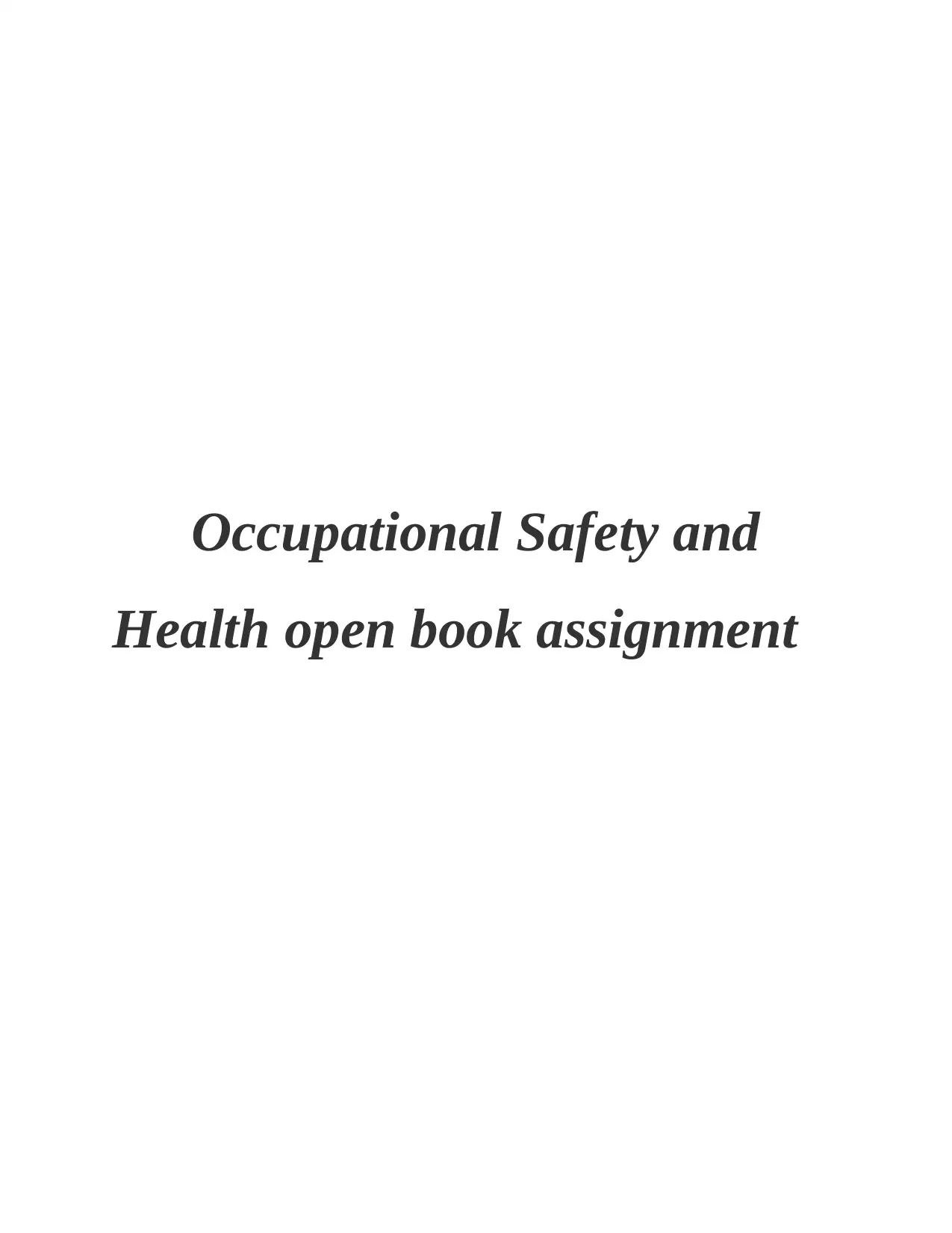
Occupational Safety and
Health open book assignment
Health open book assignment
Paraphrase This Document
Need a fresh take? Get an instant paraphrase of this document with our AI Paraphraser
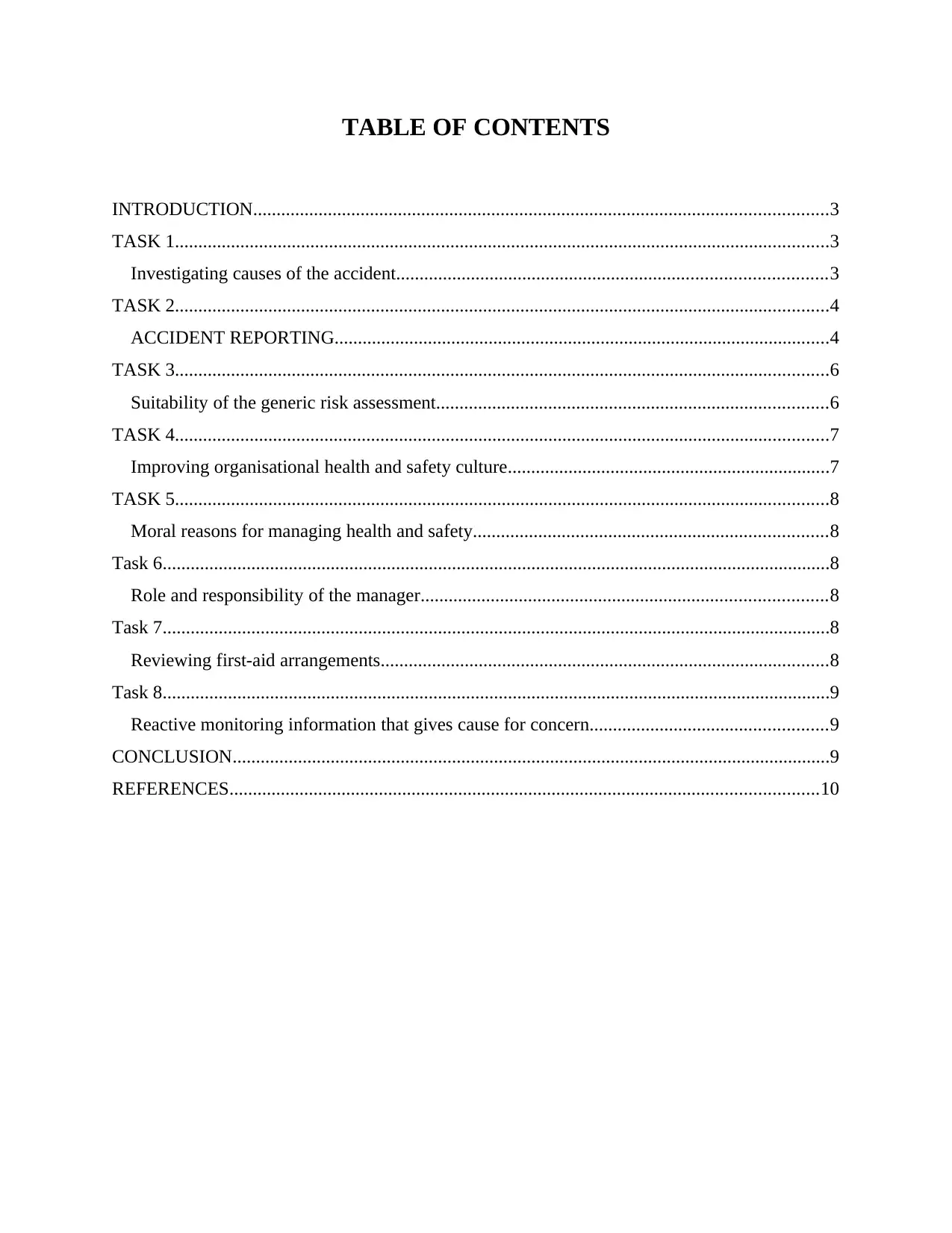
TABLE OF CONTENTS
INTRODUCTION...........................................................................................................................3
TASK 1............................................................................................................................................3
Investigating causes of the accident............................................................................................3
TASK 2............................................................................................................................................4
ACCIDENT REPORTING..........................................................................................................4
TASK 3............................................................................................................................................6
Suitability of the generic risk assessment....................................................................................6
TASK 4............................................................................................................................................7
Improving organisational health and safety culture.....................................................................7
TASK 5............................................................................................................................................8
Moral reasons for managing health and safety............................................................................8
Task 6...............................................................................................................................................8
Role and responsibility of the manager.......................................................................................8
Task 7...............................................................................................................................................8
Reviewing first-aid arrangements................................................................................................8
Task 8...............................................................................................................................................9
Reactive monitoring information that gives cause for concern...................................................9
CONCLUSION................................................................................................................................9
REFERENCES..............................................................................................................................10
INTRODUCTION...........................................................................................................................3
TASK 1............................................................................................................................................3
Investigating causes of the accident............................................................................................3
TASK 2............................................................................................................................................4
ACCIDENT REPORTING..........................................................................................................4
TASK 3............................................................................................................................................6
Suitability of the generic risk assessment....................................................................................6
TASK 4............................................................................................................................................7
Improving organisational health and safety culture.....................................................................7
TASK 5............................................................................................................................................8
Moral reasons for managing health and safety............................................................................8
Task 6...............................................................................................................................................8
Role and responsibility of the manager.......................................................................................8
Task 7...............................................................................................................................................8
Reviewing first-aid arrangements................................................................................................8
Task 8...............................................................................................................................................9
Reactive monitoring information that gives cause for concern...................................................9
CONCLUSION................................................................................................................................9
REFERENCES..............................................................................................................................10

INTRODUCTION
Health and Safety plays a major role in the companies like Removals. The report will focus
on the health and safety arrangements made at Removals Company. It will shed light on the
various causes which contributed towards the accident at the workplace. The need of reporting
the accidents by the employer to the competent authority will also be discussed. It will also focus
on the approach of the company towards health and safety and the ways in which accidents can
be prevented. The roles and responsibilities of the health and safety manager will also be
discussed and elaborated.
TASK 1
Investigating causes of the accident
The workplace can be dangerous, especially in an industrial environment. Many factors can lead
to accidents, from overwork to improper handling of hazardous materials. There are many
variables that can contribute to or influence workplace accidents. The following are the eight
most common causes of workplace accidents:
Lifting: Many employees tend to twist, twist, or tear their muscles because they lift objects that
are too heavy to lift themselves. Remember, there is nothing wrong with asking for help on
objects that are difficult to lift. Fatigue: Not resting is another common cause of accidents. To
recover from heavy physical work, employees must get plenty of rest. Failure to do so can lead
to a number of physical problems, including wasting and general fatigue. The result of any one
of them can be more devastating than a 10-minute break.
Dehydration: Not staying hydrated can also have catastrophic consequences. In the unusually hot
summer, if you can't drink enough water, it can cause heat stroke or heart disease. This can be
avoided by drinking at least eight glasses of water a day. Management must emphasize the
importance of adequate hydration and rest, because it can maximize staff efforts (Pirzadeh and
Lingard, 2017).
Insufficient lighting: Insufficient lighting causes many accidents every year. This is often
overlooked when trying to prevent accidents in warehouses or workplaces.
Hazardous Substances: Improper handling of hazardous materials or not wearing personal
protective equipment (PPE) is another common cause of workplace accidents. Many workplace
3
Health and Safety plays a major role in the companies like Removals. The report will focus
on the health and safety arrangements made at Removals Company. It will shed light on the
various causes which contributed towards the accident at the workplace. The need of reporting
the accidents by the employer to the competent authority will also be discussed. It will also focus
on the approach of the company towards health and safety and the ways in which accidents can
be prevented. The roles and responsibilities of the health and safety manager will also be
discussed and elaborated.
TASK 1
Investigating causes of the accident
The workplace can be dangerous, especially in an industrial environment. Many factors can lead
to accidents, from overwork to improper handling of hazardous materials. There are many
variables that can contribute to or influence workplace accidents. The following are the eight
most common causes of workplace accidents:
Lifting: Many employees tend to twist, twist, or tear their muscles because they lift objects that
are too heavy to lift themselves. Remember, there is nothing wrong with asking for help on
objects that are difficult to lift. Fatigue: Not resting is another common cause of accidents. To
recover from heavy physical work, employees must get plenty of rest. Failure to do so can lead
to a number of physical problems, including wasting and general fatigue. The result of any one
of them can be more devastating than a 10-minute break.
Dehydration: Not staying hydrated can also have catastrophic consequences. In the unusually hot
summer, if you can't drink enough water, it can cause heat stroke or heart disease. This can be
avoided by drinking at least eight glasses of water a day. Management must emphasize the
importance of adequate hydration and rest, because it can maximize staff efforts (Pirzadeh and
Lingard, 2017).
Insufficient lighting: Insufficient lighting causes many accidents every year. This is often
overlooked when trying to prevent accidents in warehouses or workplaces.
Hazardous Substances: Improper handling of hazardous materials or not wearing personal
protective equipment (PPE) is another common cause of workplace accidents. Many workplace
3
⊘ This is a preview!⊘
Do you want full access?
Subscribe today to unlock all pages.

Trusted by 1+ million students worldwide
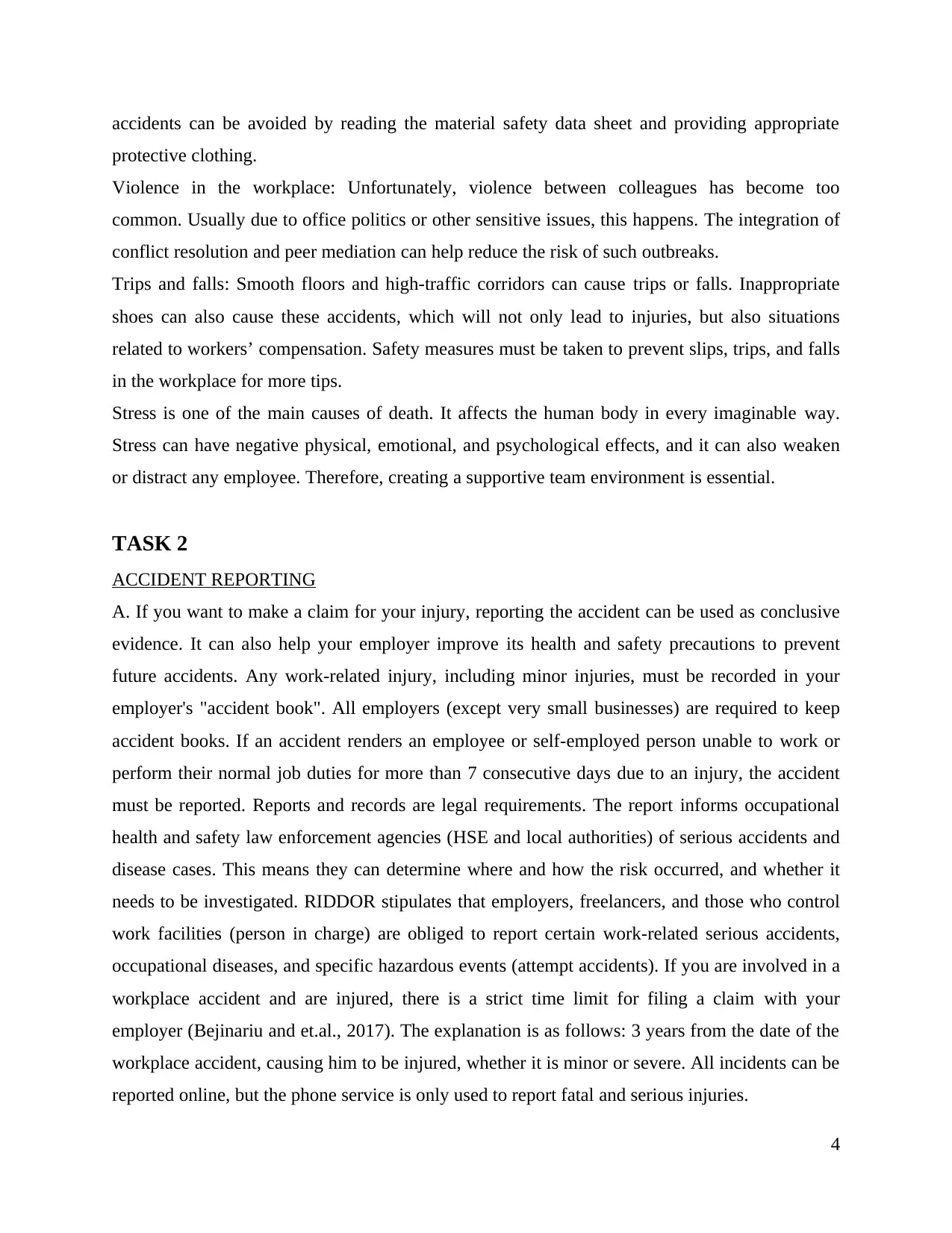
accidents can be avoided by reading the material safety data sheet and providing appropriate
protective clothing.
Violence in the workplace: Unfortunately, violence between colleagues has become too
common. Usually due to office politics or other sensitive issues, this happens. The integration of
conflict resolution and peer mediation can help reduce the risk of such outbreaks.
Trips and falls: Smooth floors and high-traffic corridors can cause trips or falls. Inappropriate
shoes can also cause these accidents, which will not only lead to injuries, but also situations
related to workers’ compensation. Safety measures must be taken to prevent slips, trips, and falls
in the workplace for more tips.
Stress is one of the main causes of death. It affects the human body in every imaginable way.
Stress can have negative physical, emotional, and psychological effects, and it can also weaken
or distract any employee. Therefore, creating a supportive team environment is essential.
TASK 2
ACCIDENT REPORTING
A. If you want to make a claim for your injury, reporting the accident can be used as conclusive
evidence. It can also help your employer improve its health and safety precautions to prevent
future accidents. Any work-related injury, including minor injuries, must be recorded in your
employer's "accident book". All employers (except very small businesses) are required to keep
accident books. If an accident renders an employee or self-employed person unable to work or
perform their normal job duties for more than 7 consecutive days due to an injury, the accident
must be reported. Reports and records are legal requirements. The report informs occupational
health and safety law enforcement agencies (HSE and local authorities) of serious accidents and
disease cases. This means they can determine where and how the risk occurred, and whether it
needs to be investigated. RIDDOR stipulates that employers, freelancers, and those who control
work facilities (person in charge) are obliged to report certain work-related serious accidents,
occupational diseases, and specific hazardous events (attempt accidents). If you are involved in a
workplace accident and are injured, there is a strict time limit for filing a claim with your
employer (Bejinariu and et.al., 2017). The explanation is as follows: 3 years from the date of the
workplace accident, causing him to be injured, whether it is minor or severe. All incidents can be
reported online, but the phone service is only used to report fatal and serious injuries.
4
protective clothing.
Violence in the workplace: Unfortunately, violence between colleagues has become too
common. Usually due to office politics or other sensitive issues, this happens. The integration of
conflict resolution and peer mediation can help reduce the risk of such outbreaks.
Trips and falls: Smooth floors and high-traffic corridors can cause trips or falls. Inappropriate
shoes can also cause these accidents, which will not only lead to injuries, but also situations
related to workers’ compensation. Safety measures must be taken to prevent slips, trips, and falls
in the workplace for more tips.
Stress is one of the main causes of death. It affects the human body in every imaginable way.
Stress can have negative physical, emotional, and psychological effects, and it can also weaken
or distract any employee. Therefore, creating a supportive team environment is essential.
TASK 2
ACCIDENT REPORTING
A. If you want to make a claim for your injury, reporting the accident can be used as conclusive
evidence. It can also help your employer improve its health and safety precautions to prevent
future accidents. Any work-related injury, including minor injuries, must be recorded in your
employer's "accident book". All employers (except very small businesses) are required to keep
accident books. If an accident renders an employee or self-employed person unable to work or
perform their normal job duties for more than 7 consecutive days due to an injury, the accident
must be reported. Reports and records are legal requirements. The report informs occupational
health and safety law enforcement agencies (HSE and local authorities) of serious accidents and
disease cases. This means they can determine where and how the risk occurred, and whether it
needs to be investigated. RIDDOR stipulates that employers, freelancers, and those who control
work facilities (person in charge) are obliged to report certain work-related serious accidents,
occupational diseases, and specific hazardous events (attempt accidents). If you are involved in a
workplace accident and are injured, there is a strict time limit for filing a claim with your
employer (Bejinariu and et.al., 2017). The explanation is as follows: 3 years from the date of the
workplace accident, causing him to be injured, whether it is minor or severe. All incidents can be
reported online, but the phone service is only used to report fatal and serious injuries.
4
Paraphrase This Document
Need a fresh take? Get an instant paraphrase of this document with our AI Paraphraser
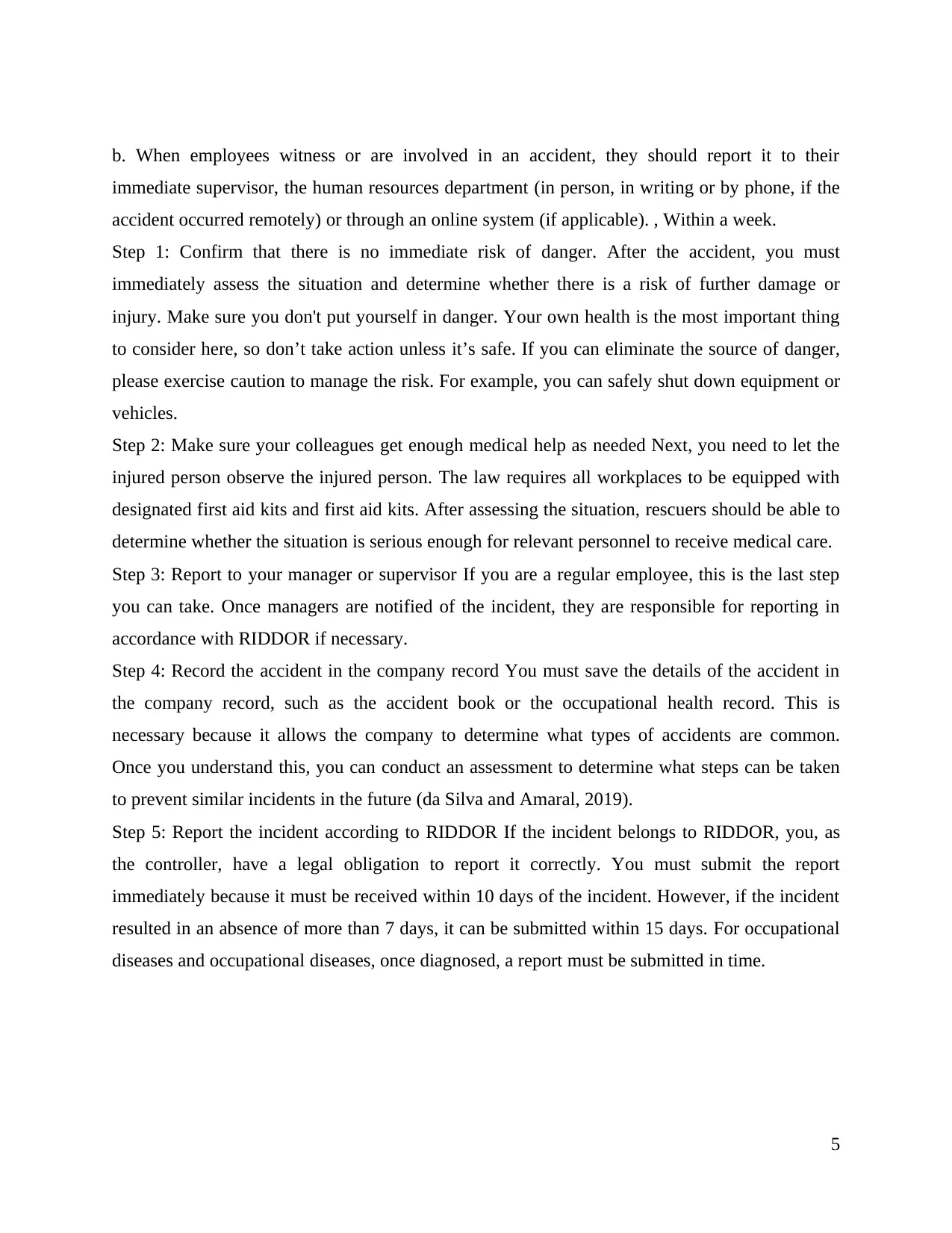
b. When employees witness or are involved in an accident, they should report it to their
immediate supervisor, the human resources department (in person, in writing or by phone, if the
accident occurred remotely) or through an online system (if applicable). , Within a week.
Step 1: Confirm that there is no immediate risk of danger. After the accident, you must
immediately assess the situation and determine whether there is a risk of further damage or
injury. Make sure you don't put yourself in danger. Your own health is the most important thing
to consider here, so don’t take action unless it’s safe. If you can eliminate the source of danger,
please exercise caution to manage the risk. For example, you can safely shut down equipment or
vehicles.
Step 2: Make sure your colleagues get enough medical help as needed Next, you need to let the
injured person observe the injured person. The law requires all workplaces to be equipped with
designated first aid kits and first aid kits. After assessing the situation, rescuers should be able to
determine whether the situation is serious enough for relevant personnel to receive medical care.
Step 3: Report to your manager or supervisor If you are a regular employee, this is the last step
you can take. Once managers are notified of the incident, they are responsible for reporting in
accordance with RIDDOR if necessary.
Step 4: Record the accident in the company record You must save the details of the accident in
the company record, such as the accident book or the occupational health record. This is
necessary because it allows the company to determine what types of accidents are common.
Once you understand this, you can conduct an assessment to determine what steps can be taken
to prevent similar incidents in the future (da Silva and Amaral, 2019).
Step 5: Report the incident according to RIDDOR If the incident belongs to RIDDOR, you, as
the controller, have a legal obligation to report it correctly. You must submit the report
immediately because it must be received within 10 days of the incident. However, if the incident
resulted in an absence of more than 7 days, it can be submitted within 15 days. For occupational
diseases and occupational diseases, once diagnosed, a report must be submitted in time.
5
immediate supervisor, the human resources department (in person, in writing or by phone, if the
accident occurred remotely) or through an online system (if applicable). , Within a week.
Step 1: Confirm that there is no immediate risk of danger. After the accident, you must
immediately assess the situation and determine whether there is a risk of further damage or
injury. Make sure you don't put yourself in danger. Your own health is the most important thing
to consider here, so don’t take action unless it’s safe. If you can eliminate the source of danger,
please exercise caution to manage the risk. For example, you can safely shut down equipment or
vehicles.
Step 2: Make sure your colleagues get enough medical help as needed Next, you need to let the
injured person observe the injured person. The law requires all workplaces to be equipped with
designated first aid kits and first aid kits. After assessing the situation, rescuers should be able to
determine whether the situation is serious enough for relevant personnel to receive medical care.
Step 3: Report to your manager or supervisor If you are a regular employee, this is the last step
you can take. Once managers are notified of the incident, they are responsible for reporting in
accordance with RIDDOR if necessary.
Step 4: Record the accident in the company record You must save the details of the accident in
the company record, such as the accident book or the occupational health record. This is
necessary because it allows the company to determine what types of accidents are common.
Once you understand this, you can conduct an assessment to determine what steps can be taken
to prevent similar incidents in the future (da Silva and Amaral, 2019).
Step 5: Report the incident according to RIDDOR If the incident belongs to RIDDOR, you, as
the controller, have a legal obligation to report it correctly. You must submit the report
immediately because it must be received within 10 days of the incident. However, if the incident
resulted in an absence of more than 7 days, it can be submitted within 15 days. For occupational
diseases and occupational diseases, once diagnosed, a report must be submitted in time.
5
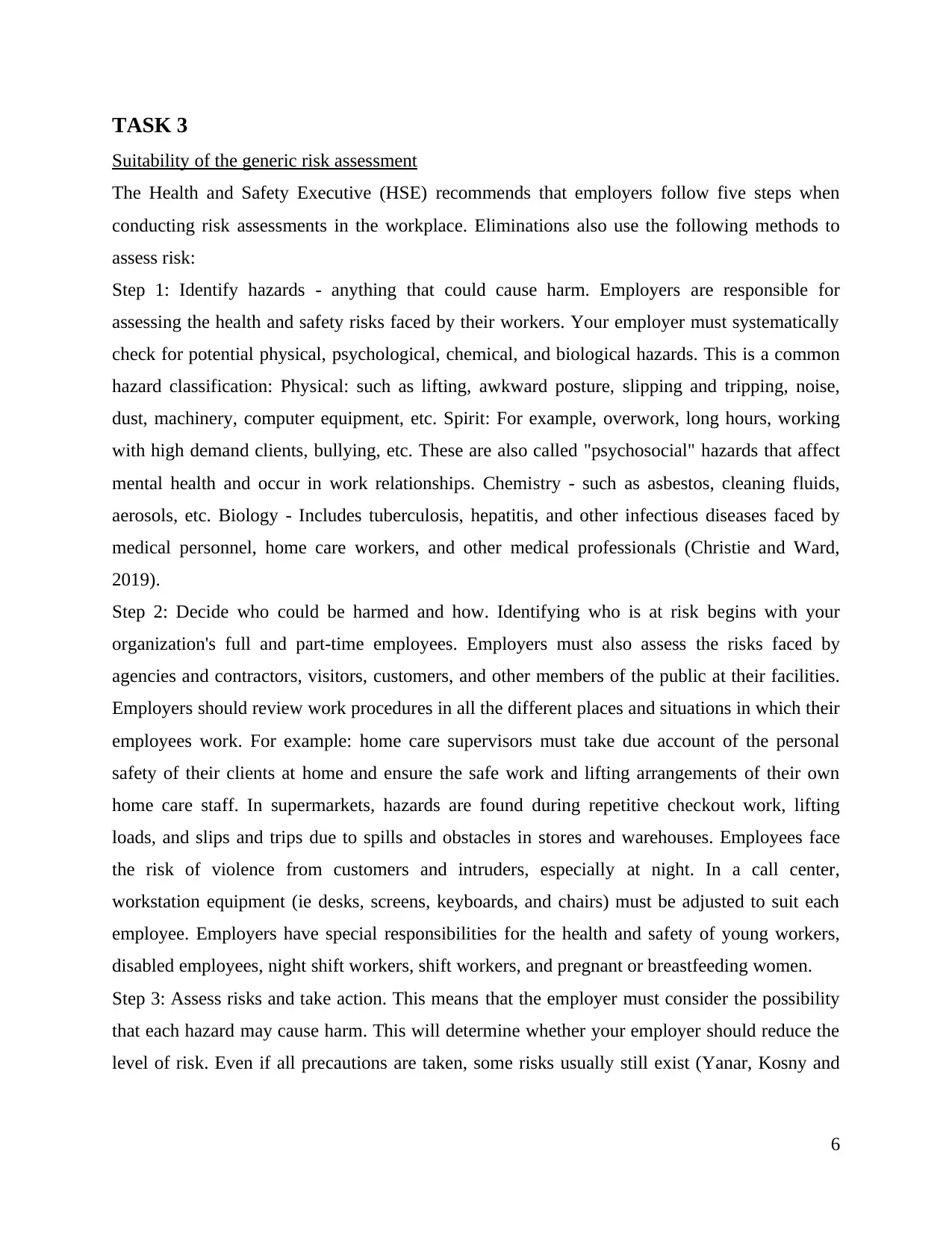
TASK 3
Suitability of the generic risk assessment
The Health and Safety Executive (HSE) recommends that employers follow five steps when
conducting risk assessments in the workplace. Eliminations also use the following methods to
assess risk:
Step 1: Identify hazards - anything that could cause harm. Employers are responsible for
assessing the health and safety risks faced by their workers. Your employer must systematically
check for potential physical, psychological, chemical, and biological hazards. This is a common
hazard classification: Physical: such as lifting, awkward posture, slipping and tripping, noise,
dust, machinery, computer equipment, etc. Spirit: For example, overwork, long hours, working
with high demand clients, bullying, etc. These are also called "psychosocial" hazards that affect
mental health and occur in work relationships. Chemistry - such as asbestos, cleaning fluids,
aerosols, etc. Biology - Includes tuberculosis, hepatitis, and other infectious diseases faced by
medical personnel, home care workers, and other medical professionals (Christie and Ward,
2019).
Step 2: Decide who could be harmed and how. Identifying who is at risk begins with your
organization's full and part-time employees. Employers must also assess the risks faced by
agencies and contractors, visitors, customers, and other members of the public at their facilities.
Employers should review work procedures in all the different places and situations in which their
employees work. For example: home care supervisors must take due account of the personal
safety of their clients at home and ensure the safe work and lifting arrangements of their own
home care staff. In supermarkets, hazards are found during repetitive checkout work, lifting
loads, and slips and trips due to spills and obstacles in stores and warehouses. Employees face
the risk of violence from customers and intruders, especially at night. In a call center,
workstation equipment (ie desks, screens, keyboards, and chairs) must be adjusted to suit each
employee. Employers have special responsibilities for the health and safety of young workers,
disabled employees, night shift workers, shift workers, and pregnant or breastfeeding women.
Step 3: Assess risks and take action. This means that the employer must consider the possibility
that each hazard may cause harm. This will determine whether your employer should reduce the
level of risk. Even if all precautions are taken, some risks usually still exist (Yanar, Kosny and
6
Suitability of the generic risk assessment
The Health and Safety Executive (HSE) recommends that employers follow five steps when
conducting risk assessments in the workplace. Eliminations also use the following methods to
assess risk:
Step 1: Identify hazards - anything that could cause harm. Employers are responsible for
assessing the health and safety risks faced by their workers. Your employer must systematically
check for potential physical, psychological, chemical, and biological hazards. This is a common
hazard classification: Physical: such as lifting, awkward posture, slipping and tripping, noise,
dust, machinery, computer equipment, etc. Spirit: For example, overwork, long hours, working
with high demand clients, bullying, etc. These are also called "psychosocial" hazards that affect
mental health and occur in work relationships. Chemistry - such as asbestos, cleaning fluids,
aerosols, etc. Biology - Includes tuberculosis, hepatitis, and other infectious diseases faced by
medical personnel, home care workers, and other medical professionals (Christie and Ward,
2019).
Step 2: Decide who could be harmed and how. Identifying who is at risk begins with your
organization's full and part-time employees. Employers must also assess the risks faced by
agencies and contractors, visitors, customers, and other members of the public at their facilities.
Employers should review work procedures in all the different places and situations in which their
employees work. For example: home care supervisors must take due account of the personal
safety of their clients at home and ensure the safe work and lifting arrangements of their own
home care staff. In supermarkets, hazards are found during repetitive checkout work, lifting
loads, and slips and trips due to spills and obstacles in stores and warehouses. Employees face
the risk of violence from customers and intruders, especially at night. In a call center,
workstation equipment (ie desks, screens, keyboards, and chairs) must be adjusted to suit each
employee. Employers have special responsibilities for the health and safety of young workers,
disabled employees, night shift workers, shift workers, and pregnant or breastfeeding women.
Step 3: Assess risks and take action. This means that the employer must consider the possibility
that each hazard may cause harm. This will determine whether your employer should reduce the
level of risk. Even if all precautions are taken, some risks usually still exist (Yanar, Kosny and
6
⊘ This is a preview!⊘
Do you want full access?
Subscribe today to unlock all pages.

Trusted by 1+ million students worldwide
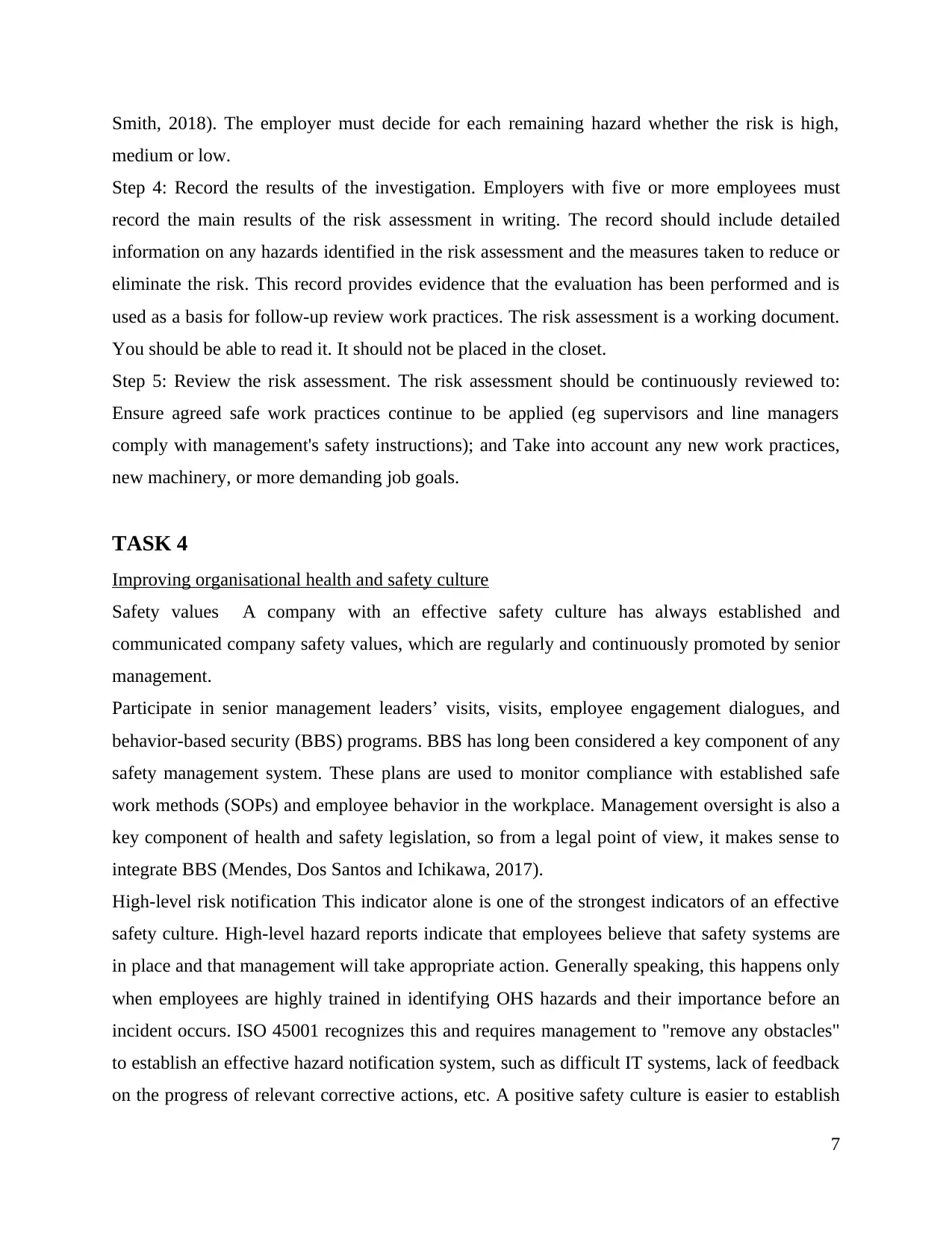
Smith, 2018). The employer must decide for each remaining hazard whether the risk is high,
medium or low.
Step 4: Record the results of the investigation. Employers with five or more employees must
record the main results of the risk assessment in writing. The record should include detailed
information on any hazards identified in the risk assessment and the measures taken to reduce or
eliminate the risk. This record provides evidence that the evaluation has been performed and is
used as a basis for follow-up review work practices. The risk assessment is a working document.
You should be able to read it. It should not be placed in the closet.
Step 5: Review the risk assessment. The risk assessment should be continuously reviewed to:
Ensure agreed safe work practices continue to be applied (eg supervisors and line managers
comply with management's safety instructions); and Take into account any new work practices,
new machinery, or more demanding job goals.
TASK 4
Improving organisational health and safety culture
Safety values A company with an effective safety culture has always established and
communicated company safety values, which are regularly and continuously promoted by senior
management.
Participate in senior management leaders’ visits, visits, employee engagement dialogues, and
behavior-based security (BBS) programs. BBS has long been considered a key component of any
safety management system. These plans are used to monitor compliance with established safe
work methods (SOPs) and employee behavior in the workplace. Management oversight is also a
key component of health and safety legislation, so from a legal point of view, it makes sense to
integrate BBS (Mendes, Dos Santos and Ichikawa, 2017).
High-level risk notification This indicator alone is one of the strongest indicators of an effective
safety culture. High-level hazard reports indicate that employees believe that safety systems are
in place and that management will take appropriate action. Generally speaking, this happens only
when employees are highly trained in identifying OHS hazards and their importance before an
incident occurs. ISO 45001 recognizes this and requires management to "remove any obstacles"
to establish an effective hazard notification system, such as difficult IT systems, lack of feedback
on the progress of relevant corrective actions, etc. A positive safety culture is easier to establish
7
medium or low.
Step 4: Record the results of the investigation. Employers with five or more employees must
record the main results of the risk assessment in writing. The record should include detailed
information on any hazards identified in the risk assessment and the measures taken to reduce or
eliminate the risk. This record provides evidence that the evaluation has been performed and is
used as a basis for follow-up review work practices. The risk assessment is a working document.
You should be able to read it. It should not be placed in the closet.
Step 5: Review the risk assessment. The risk assessment should be continuously reviewed to:
Ensure agreed safe work practices continue to be applied (eg supervisors and line managers
comply with management's safety instructions); and Take into account any new work practices,
new machinery, or more demanding job goals.
TASK 4
Improving organisational health and safety culture
Safety values A company with an effective safety culture has always established and
communicated company safety values, which are regularly and continuously promoted by senior
management.
Participate in senior management leaders’ visits, visits, employee engagement dialogues, and
behavior-based security (BBS) programs. BBS has long been considered a key component of any
safety management system. These plans are used to monitor compliance with established safe
work methods (SOPs) and employee behavior in the workplace. Management oversight is also a
key component of health and safety legislation, so from a legal point of view, it makes sense to
integrate BBS (Mendes, Dos Santos and Ichikawa, 2017).
High-level risk notification This indicator alone is one of the strongest indicators of an effective
safety culture. High-level hazard reports indicate that employees believe that safety systems are
in place and that management will take appropriate action. Generally speaking, this happens only
when employees are highly trained in identifying OHS hazards and their importance before an
incident occurs. ISO 45001 recognizes this and requires management to "remove any obstacles"
to establish an effective hazard notification system, such as difficult IT systems, lack of feedback
on the progress of relevant corrective actions, etc. A positive safety culture is easier to establish
7
Paraphrase This Document
Need a fresh take? Get an instant paraphrase of this document with our AI Paraphraser
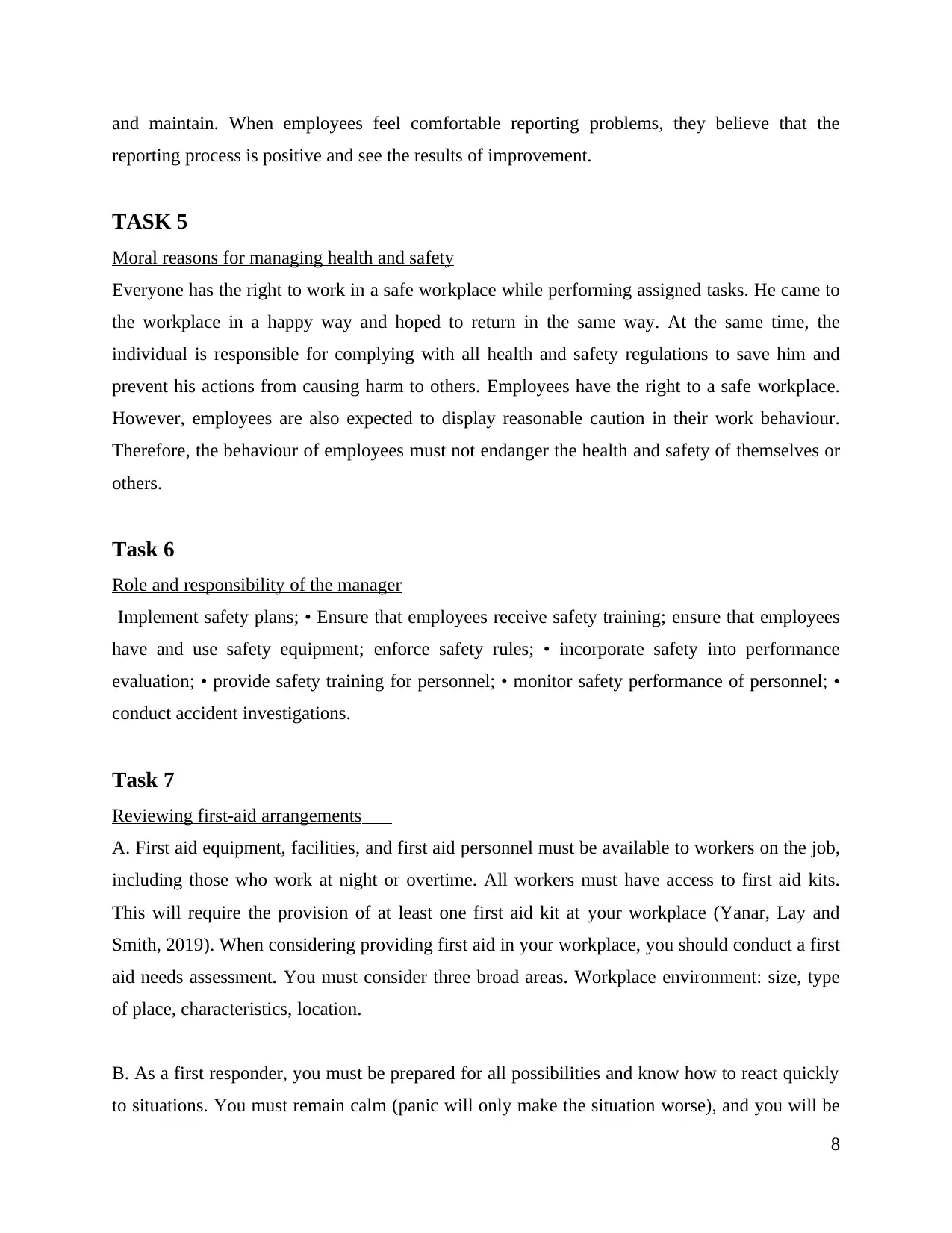
and maintain. When employees feel comfortable reporting problems, they believe that the
reporting process is positive and see the results of improvement.
TASK 5
Moral reasons for managing health and safety
Everyone has the right to work in a safe workplace while performing assigned tasks. He came to
the workplace in a happy way and hoped to return in the same way. At the same time, the
individual is responsible for complying with all health and safety regulations to save him and
prevent his actions from causing harm to others. Employees have the right to a safe workplace.
However, employees are also expected to display reasonable caution in their work behaviour.
Therefore, the behaviour of employees must not endanger the health and safety of themselves or
others.
Task 6
Role and responsibility of the manager
Implement safety plans; • Ensure that employees receive safety training; ensure that employees
have and use safety equipment; enforce safety rules; • incorporate safety into performance
evaluation; • provide safety training for personnel; • monitor safety performance of personnel; •
conduct accident investigations.
Task 7
Reviewing first-aid arrangements
A. First aid equipment, facilities, and first aid personnel must be available to workers on the job,
including those who work at night or overtime. All workers must have access to first aid kits.
This will require the provision of at least one first aid kit at your workplace (Yanar, Lay and
Smith, 2019). When considering providing first aid in your workplace, you should conduct a first
aid needs assessment. You must consider three broad areas. Workplace environment: size, type
of place, characteristics, location.
B. As a first responder, you must be prepared for all possibilities and know how to react quickly
to situations. You must remain calm (panic will only make the situation worse), and you will be
8
reporting process is positive and see the results of improvement.
TASK 5
Moral reasons for managing health and safety
Everyone has the right to work in a safe workplace while performing assigned tasks. He came to
the workplace in a happy way and hoped to return in the same way. At the same time, the
individual is responsible for complying with all health and safety regulations to save him and
prevent his actions from causing harm to others. Employees have the right to a safe workplace.
However, employees are also expected to display reasonable caution in their work behaviour.
Therefore, the behaviour of employees must not endanger the health and safety of themselves or
others.
Task 6
Role and responsibility of the manager
Implement safety plans; • Ensure that employees receive safety training; ensure that employees
have and use safety equipment; enforce safety rules; • incorporate safety into performance
evaluation; • provide safety training for personnel; • monitor safety performance of personnel; •
conduct accident investigations.
Task 7
Reviewing first-aid arrangements
A. First aid equipment, facilities, and first aid personnel must be available to workers on the job,
including those who work at night or overtime. All workers must have access to first aid kits.
This will require the provision of at least one first aid kit at your workplace (Yanar, Lay and
Smith, 2019). When considering providing first aid in your workplace, you should conduct a first
aid needs assessment. You must consider three broad areas. Workplace environment: size, type
of place, characteristics, location.
B. As a first responder, you must be prepared for all possibilities and know how to react quickly
to situations. You must remain calm (panic will only make the situation worse), and you will be
8
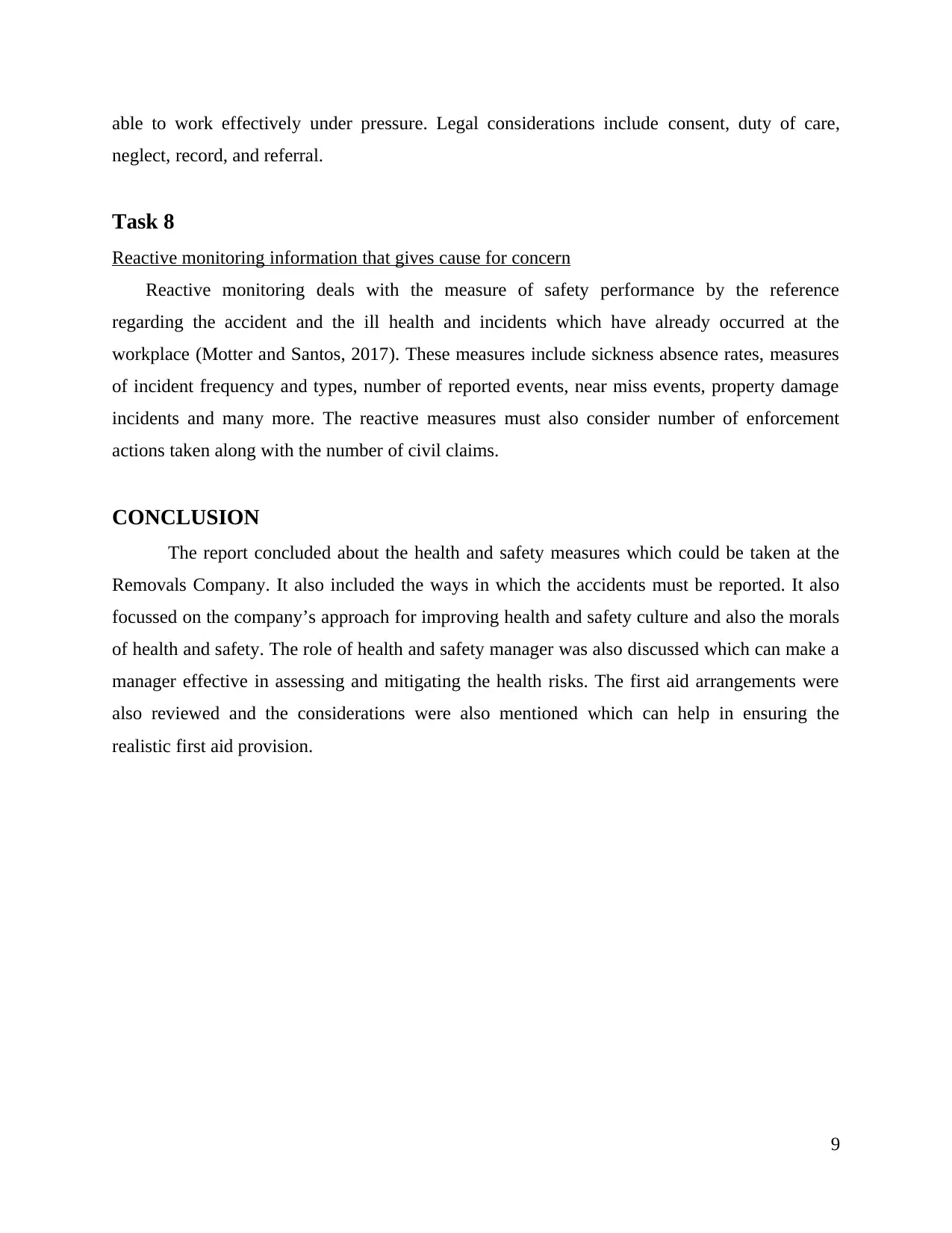
able to work effectively under pressure. Legal considerations include consent, duty of care,
neglect, record, and referral.
Task 8
Reactive monitoring information that gives cause for concern
Reactive monitoring deals with the measure of safety performance by the reference
regarding the accident and the ill health and incidents which have already occurred at the
workplace (Motter and Santos, 2017). These measures include sickness absence rates, measures
of incident frequency and types, number of reported events, near miss events, property damage
incidents and many more. The reactive measures must also consider number of enforcement
actions taken along with the number of civil claims.
CONCLUSION
The report concluded about the health and safety measures which could be taken at the
Removals Company. It also included the ways in which the accidents must be reported. It also
focussed on the company’s approach for improving health and safety culture and also the morals
of health and safety. The role of health and safety manager was also discussed which can make a
manager effective in assessing and mitigating the health risks. The first aid arrangements were
also reviewed and the considerations were also mentioned which can help in ensuring the
realistic first aid provision.
9
neglect, record, and referral.
Task 8
Reactive monitoring information that gives cause for concern
Reactive monitoring deals with the measure of safety performance by the reference
regarding the accident and the ill health and incidents which have already occurred at the
workplace (Motter and Santos, 2017). These measures include sickness absence rates, measures
of incident frequency and types, number of reported events, near miss events, property damage
incidents and many more. The reactive measures must also consider number of enforcement
actions taken along with the number of civil claims.
CONCLUSION
The report concluded about the health and safety measures which could be taken at the
Removals Company. It also included the ways in which the accidents must be reported. It also
focussed on the company’s approach for improving health and safety culture and also the morals
of health and safety. The role of health and safety manager was also discussed which can make a
manager effective in assessing and mitigating the health risks. The first aid arrangements were
also reviewed and the considerations were also mentioned which can help in ensuring the
realistic first aid provision.
9
⊘ This is a preview!⊘
Do you want full access?
Subscribe today to unlock all pages.

Trusted by 1+ million students worldwide
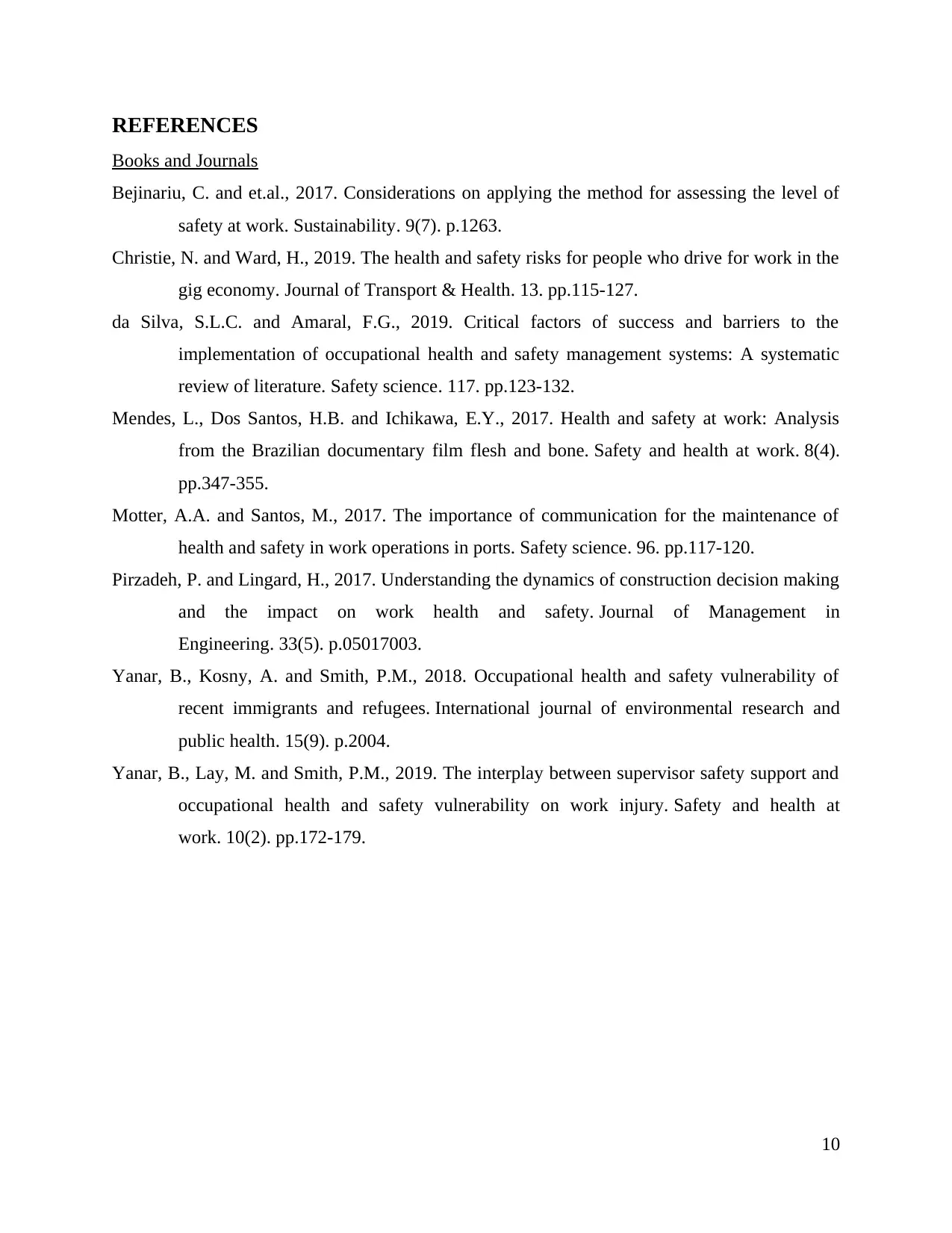
REFERENCES
Books and Journals
Bejinariu, C. and et.al., 2017. Considerations on applying the method for assessing the level of
safety at work. Sustainability. 9(7). p.1263.
Christie, N. and Ward, H., 2019. The health and safety risks for people who drive for work in the
gig economy. Journal of Transport & Health. 13. pp.115-127.
da Silva, S.L.C. and Amaral, F.G., 2019. Critical factors of success and barriers to the
implementation of occupational health and safety management systems: A systematic
review of literature. Safety science. 117. pp.123-132.
Mendes, L., Dos Santos, H.B. and Ichikawa, E.Y., 2017. Health and safety at work: Analysis
from the Brazilian documentary film flesh and bone. Safety and health at work. 8(4).
pp.347-355.
Motter, A.A. and Santos, M., 2017. The importance of communication for the maintenance of
health and safety in work operations in ports. Safety science. 96. pp.117-120.
Pirzadeh, P. and Lingard, H., 2017. Understanding the dynamics of construction decision making
and the impact on work health and safety. Journal of Management in
Engineering. 33(5). p.05017003.
Yanar, B., Kosny, A. and Smith, P.M., 2018. Occupational health and safety vulnerability of
recent immigrants and refugees. International journal of environmental research and
public health. 15(9). p.2004.
Yanar, B., Lay, M. and Smith, P.M., 2019. The interplay between supervisor safety support and
occupational health and safety vulnerability on work injury. Safety and health at
work. 10(2). pp.172-179.
10
Books and Journals
Bejinariu, C. and et.al., 2017. Considerations on applying the method for assessing the level of
safety at work. Sustainability. 9(7). p.1263.
Christie, N. and Ward, H., 2019. The health and safety risks for people who drive for work in the
gig economy. Journal of Transport & Health. 13. pp.115-127.
da Silva, S.L.C. and Amaral, F.G., 2019. Critical factors of success and barriers to the
implementation of occupational health and safety management systems: A systematic
review of literature. Safety science. 117. pp.123-132.
Mendes, L., Dos Santos, H.B. and Ichikawa, E.Y., 2017. Health and safety at work: Analysis
from the Brazilian documentary film flesh and bone. Safety and health at work. 8(4).
pp.347-355.
Motter, A.A. and Santos, M., 2017. The importance of communication for the maintenance of
health and safety in work operations in ports. Safety science. 96. pp.117-120.
Pirzadeh, P. and Lingard, H., 2017. Understanding the dynamics of construction decision making
and the impact on work health and safety. Journal of Management in
Engineering. 33(5). p.05017003.
Yanar, B., Kosny, A. and Smith, P.M., 2018. Occupational health and safety vulnerability of
recent immigrants and refugees. International journal of environmental research and
public health. 15(9). p.2004.
Yanar, B., Lay, M. and Smith, P.M., 2019. The interplay between supervisor safety support and
occupational health and safety vulnerability on work injury. Safety and health at
work. 10(2). pp.172-179.
10
1 out of 10
Related Documents
Your All-in-One AI-Powered Toolkit for Academic Success.
+13062052269
info@desklib.com
Available 24*7 on WhatsApp / Email
![[object Object]](/_next/static/media/star-bottom.7253800d.svg)
Unlock your academic potential
Copyright © 2020–2025 A2Z Services. All Rights Reserved. Developed and managed by ZUCOL.




